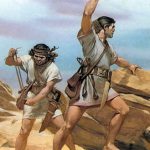Balearii was a unit of soldiers from the Balearic Archipelago, who most likely derive their name from the Greek verb “ballein”, meaning cast. The name was given to them by the ancient Romans, but probably the warriors were already known in the Bronze Age.
The soldiers did not wear armor, so they were manoeuvrable and fast. Their only equipment was a thong with a handle, with the help of which, with great strength and accuracy, they were throwing stone and lead balls. A skilled slinger was able to hit an opponent in a given body part even from 100 meters. Theodorus recalled that an accurate sling shot caused bruises and shock to the wounded. In some areas of the Mediterranean Sea this method of fighting is still used for hunting small animals.
In the Balearic Islands, the manner of fighting has evolved into a sport in time. Until the conquest of the islands, the inhabitants used the slingshot to fight, as their most important weapon. The slingshot was made of vegetable fibers, animal tendons or horsehair. Bullets made of stone usually weighed 0.5 kilograms. Strabon and Diodorus the Sicilian – Greek historians – wrote that the warriors carried three slingshots with them. Slingers in battle were the first to run ahead and shoot at the opponent. Heavy infantry attacked after them.
Hannibal greatly appreciated Balearic artillery. For the expedition, during the second Punic War with Rome in 218 BCE, he crossed the Alps with 37 elephants and about 2,000 slingers. We can read about how they fought in the epic “Punica Silius Italicus”. The slingers were forgotten during the Pax Romana period.
The rule of the Romans in the Balearic Islands occurred as a result of military intervention in 123 BCE, which was caused by Majorca’s provocations. Quintus Caecilius Metellus and his navy entered the bay of Alcudia capturing the island. For this act, the Roman senate awarded him the title of “Balearicus”. Pollentia became the capital of the new province. Colonists, numbering 3,000, settled among others in Palmaria (Palma), Cunici (Manacor), Sinium (Sineu), Bocchrois (Port de Pollenca). Diodorus writes that around 30,000 people lived in the Balearic era in the first century.
When the Romans entered Majorca, they began to build squares, streets and bridges. They created markets, built temples and theaters; they also conducted efficient administration; large agricultural estates appeared; and the economy was based on the cultivation of vines and olive trees. Pottery was also important because there are rich deposits of clay in Majorca.
At the end of the 2nd century CE Christianity spread over the Iberian Peninsula, which quickly reached Majorca and had its strong position here in the 4th century.
King Gaiseric leading the Vandals in 455 CE captured Majorca, he plundered the island and destroyed Roman culture and rule.
To this day, few memorabilia have survived from the time of Roman mastery. In Pollentia, the bridge over Torrent de Sant Jordi from the 2nd century CE, as well as the ruins of the Roman theater from the 1st century CE survived. This theater was discovered in 1952 off the beaten path of the road leading to Port d’Alcudia. It is one of the smallest Roman theaters in Spain – it has only 2,000 spectators. The object has rows of seats and a place for choir and dancers. Later, the hill on which the theater was built was used as a cemetery, as indicated by the tombs found next to it. In addition, the Museu Monografic de Pollentia in Alcudia collected interesting finds from Roman times, e.g. a marble torso, a warrior statue and everyday objects.






